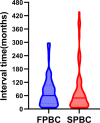Clinical characteristics and survival of breast cancer patients with extramammary malignancies in a single Asian center over the past 23 years
- PMID: 40397227
- PMCID: PMC12095712
- DOI: 10.1007/s12672-025-02162-6
Clinical characteristics and survival of breast cancer patients with extramammary malignancies in a single Asian center over the past 23 years
Abstract
Background: The rise of multiple primary malignant neoplasms (MPMNs) necessitates exploration. MPMNs represent 18% of U.S. cancers. Breast cancer is the predominant malignancy among female Americans. However, most studies on breast cancer with MPMNs are confined to case reports with small sample sizes. Hence, this article scrutinizes 280 patients diagnosed with breast cancer and extramammary primary malignancies via long-term follow-up.
Methods: We reviewed 280 breast cancer cases with extramammary primary malignancies from January 2000 to December 2022 at our institute, excluding those diagnosed with stage IV breast cancer. The double primary malignant neoplasms (DPMNs) were used as focal points and segregated into the first primary breast cancer (FPBC) and second primary breast cancer (SPBC) subgroups. With a median follow-up period of 107 months (8.9 years), we examined the characteristics of these diseases in various patients.
Results: Concerning breast cancer patients with extramammary primary malignancies, DPMNs were predominant, comprising 77.1% (216/280). Among these DPNMs, gynecology, thyroid, and lung were the primary site of extramammary tumors, predominantly. Nearly all (93.9%) of FPBC patients exhibited metachronous cancer whereas 55.9% of SPBC patients experienced this. The median interval between the onset of breast cancer and extramammary malignancy in metachronous FPBC and metachronous SPBC patients was 60 months and 48 months, respectively. Over time, both metachronous FPBC and metachronous SPBC patients demonstrated a diminishing prevalence of second tumors. The distinction lay in that in the metachronous FPBC group, second tumors ceased to occur after 300 months, whereas in the metachronous SPBC group, their emergence persisted. Synchronous cancer, negative ER/PR status, and advanced extramammary malignancy stage portend poor prognosis among patients with DPMNs.
Conclusions: Careful monitoring of MPMNs necessitates precise guidelines, differing amongst FPBC and SPBC patients. Synchronous cancer, ER/PR-negative, and advanced extramammary malignancy stage indicate poor prognosis in DPMNs patients.
Keywords: Breast cancer; Double primary malignant neoplasms; Extramammary malignancy; Multiple primary malignant neoplasms.
© 2025. The Author(s).
Conflict of interest statement
Declarations. Ethics approval and consent to participate: Studies involving human participants were approved and reviewed by the Medical Ethics Committee of Tianjin Medical University Cancer Institute & Hospital. Informed consent has been obtained from the patients for the study. The research was carried out following the guidelines of the ethics committee listed in the ethics statement. Consent for publication: Not applicable. Competing interests: The authors declare no competing interests.
Figures




Similar articles
-
Clinical characteristics and survival of second primary breast carcinoma with extramammary malignancies.Front Oncol. 2023 Mar 17;13:1160370. doi: 10.3389/fonc.2023.1160370. eCollection 2023. Front Oncol. 2023. PMID: 37007094 Free PMC article.
-
Tumor marker phenotype concordance in second primary breast cancer, California, 1999-2004.Breast Cancer Res Treat. 2010 Feb;120(1):217-27. doi: 10.1007/s10549-009-0469-z. Epub 2009 Jul 21. Breast Cancer Res Treat. 2010. PMID: 19629680
-
The changes of subtype markers between first and second primary breast cancers.Cancer Med. 2023 Jun;12(12):13649-13660. doi: 10.1002/cam4.5979. Epub 2023 Apr 25. Cancer Med. 2023. PMID: 37096879 Free PMC article.
-
Multiple primary cancers: An enigma.South Asian J Cancer. 2016 Jan-Mar;5(1):29-32. doi: 10.4103/2278-330X.179698. South Asian J Cancer. 2016. PMID: 27169120 Free PMC article. Review.
-
Distinct patterns of occurrence, common associations, and survival of patients with second primary maligancies: A 5-year single institute experience with review of literature.Indian J Pathol Microbiol. 2021 Oct-Dec;64(4):725-731. doi: 10.4103/IJPM.IJPM_1055_20. Indian J Pathol Microbiol. 2021. PMID: 34673592 Review.
References
-
- Ikubo A, Matsufuji S, Morifuji Y, Koga H, Kobarai T, Kouya N, et al. Clinical features, prognosis, diagnostic approaches and treatment of multiple primary malignancies in the digestive system. Anticancer Res. 2019;39(12):6863–70. - PubMed
-
- Billroth T. Die Allgemeine chirurgische pathologie und therapie in 51 Vorlesungen: Ein Handbuch fur Studirende und Aerzte. Berlin: Reimer; 1889.
-
- Moertel CG, Dockerty MB, Baggenstoss AH. Multiple primary malignant neoplasms. II. Tumors of different tissues or organs. Cancer. 1961;14:231–7. - PubMed
-
- Koubkova L, Hrstka R, Dobes P, Vojtesek B, Vyzula R. Second primary cancers - causes, incidence and the future. Klin Onkol. 2014;27(1):11–7. - PubMed
LinkOut - more resources
Full Text Sources
Research Materials
Miscellaneous
